The new skills of print or photo such as a copperplate print or lithograph that were brought from the end of Edo period were put to practical use in around Meiji 20th and the skills of traditional woodblock print that were kept in e-shi (paint artist), hori-shi (who carve woodblock) and suri-shi (who print ukiyo-e) individually became behind the times and ukiyo-e started to be declining gradually.
At that time, in the era that ukiyo-e was declining, the genre of “rekishi-ga” (historical ukiyo-e) got to be popular. Rekishi-ga was belong to the musha-e (ukiyo-e of warrior) of Edo period. But different from musha-e that expresses battles of warriors who are brave and daring by heroic deformation that is peculiar in ukiyo-e, rekishi-ga expresses loyalty and moral based on historical facts, authentic period costumes, customs and historical investigation about the time. “Zenken Kojitu” (by Kikuchi Yōsai) that is biographical writings with portraits and published in Meiji 1st was the bible of rekishi-ga and affected it. And Tukioka Yoshitoshi pioneered in the style of rekishi-ga. This popularity of rekishi-ga spread throughout not only ukiyo-e but also all of modern Japanese drawings.
In such a boom of rekishi-ga in Japanese drawings and ukiyo-e from the middle of Meiji, though sensō-ga (ukiyo-e of war) was out of time because of lack of speed as news, many ukiyo-e that subjected on the war of Nisshin in Meiji 27th and 28th were created.

Tsukioka Yoshitoshi
“Dai Nihon Meishō Kagami Yamato Takeruno Mikoto”
Meiji 11th ~13th (1878~1880)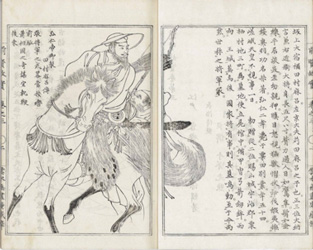
Kikuchi Yōsai
“Zenken Kojitu San-kan Jō Sakanoueno Tamuramaro”
Beginning of Meiji period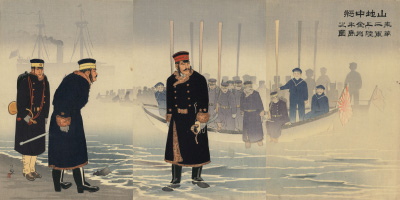
Kobayashi Kiyochika
“Yamaji Chūjō Dai Ni-gun Hikiiru Kinshū-hantō Jōriku no Zu”
Meiji 27th (1894)
Most of ukiyo-e-shi who debuted in the Edo period and was at the height of its prosperity in the beginning of Meiji passed away, the printing skills except woodblock print were developed and the pupils of that ukiyo-e-shi presented new scenes as a next generation.
One of the new scenes was creating illustrations for newspapers, magazines or modern literary magazines which was called “Mokuhan Kuchi-e” and creating designs for chinaware to keep earnings on behalf of ukiyo-e. The other was establishing a position as a modern Japanese painter by sending handwriting Japanese drawings to exhibitions. These actions were part of the actions that happened not only in ukiyo-e-shi but also in the all of the society of Japanese drawings because of the lack of patronage by the Edo Shogunate or han (clan). They earned money by the illustrations and kuchi-e stably and had established artistic circles by creating parties or holding exhibitions. The next generation exchanged with the painters who hold the dawn of the modern Japanese drawing, be a member of them and played an active part.
In the era ukiyo-e was declining, this exchange of ukiyo-e-shi and the world of modern Japanese drawing leaded the style of drawing in the latter part of Meiji and created high quality art works. Among them, the art works of bijin-hūzoku-ga (print/drawing of beautiful women with the customs at that time) are excellent and the flow reached to the masters of modern Japanese drawing of bijin-ga (print/drawing of beautiful women), Kaburaki Kiyokata and Itō Shinsui.
Moreover, in this era, not only e-shi but also hori-shi and suri-shi who shoulder the traditional woodblock print developed skills with trial and error on the new stages such as kuchi-e of modern literature or reproductions of old drawings that represented by “Kokka”. These activities not only reached to the revival of the traditional woodblock print in the Taishō and the beginning of Shōwa period but also became the base to create excellent art works at the same era. “Shin-han-ga” is the symbol of the revival.
We introduce 3 of ukiyo-e-shi who played active parts after Meiji 20s as the next generation.
- Migita Toshihide Bunkyū 3rd to Taishō 14th (1863 ~ 1925)Open or Close
He was born in Usuki-machi, Oita prefecture. In Meiji 9th, he went to Tokyo to learn western and Japanese styles of drawing and in Meiji 17th, he became a pupil of Tukioka Yoshitoshi. From around Meiji 20th, he became popular for illustrations on newspaper novels and participated in organizing Nihon Bijutu Kyōkai (means, Japan Art Association). In Meiji 25th, he became a judge in the first exhibition by Nihon Seinen Kaiga Kyōkai (means, Japan Youth Art Association) whose president was Okakura Tenshin. He also sent his own works to exhibitions as a Japanese-style painter.
Not so many, but he created kuchi-e from Meiji 20s to the Taishō period. He inherited the style of Yoshitoshi and was very good at rekishi-ga such as “Eiyū Sanjū-roku Kasen” or “Meiyo Jū-hachi Ban”. Bijin-ga such as “Bijin Jū-ni Shi” is also one of his master pieces. He is a leading figure in the world of print in Meiji and Hirezaki Eihō was one of his pupils.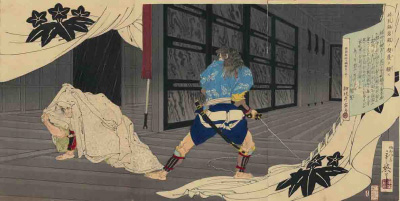
“Tokimune Kamakura-den no Jinya wo Sawagasu”
Meiji 24th (1891)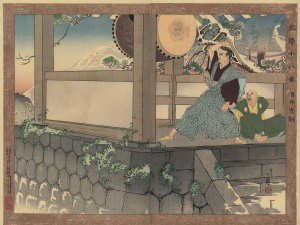
“Meiyo Jū-hachi-ban Sakai Tadatugu”
Meiji 26th (1893)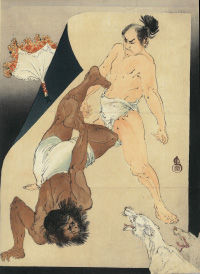
Kuchi-e “Hinodejima Hakuzen no Maki”
Meiji 33rd (1900)
'Bijin Jū-ni Sugata'
“Kisaragi” “Uzuki” “Minazuki” “Nagatuki” “Shiwasu”
Meiji 34th (1901)
From the middle of Meiji, the influence by the pupils of Tukioka Yoshitoshi were strong and he also played an active part as a Japanese-style painter on rekishi-ga mainly.
We also introduce the art works by the 2nd Utagawa Yoshimune and Yūsai Toshiaki who were the pupils of Yoshitoshi.
●Utagawa Yoshimune the 2nd
Bunkyū 3rd to Shōwa 16th (1863 ~ 1941)
-
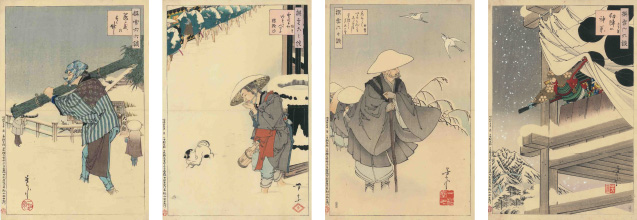
“Sen Setu Roku Roku Dan” “Shinran” “Setugi no Susutake” “Kanri” “Uijin no Shinsaku”
Meiji 25th (1892)
●Yūsai Toshiaki
Genji 1st to Taishō 10th (1864 ~ 1921)
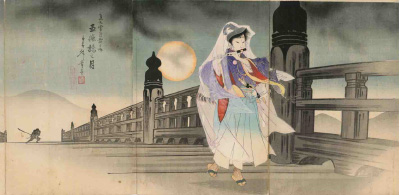
“Mitate Setugekka no uchi Gojōhashi no Tuki”
Meiji 30th (1897)
- Mizuno Toshikata Keiō 2nd to Meiji 41th (1866 ~ 1908)Open or Close
Toshikata leaded the most powerful party, Yoshitoshi party, in the world of ukiyo-e in the middle Meiji and tried to fuse ukiyo-e and modern Japanese drawing. He was one of the main person who contributed to establish the new style of modern ukiyo-e in the latter half of Meiji and establish the position of ukiyo-e party in Japanese art circles.
Toshikata became a pupil of Yoshitoshi, debuted in around Meiji 17th and created many illustrations for newspapers with Yoshitoshi. On “Tokyo Ryūkō Saiken” (means, Tokyo Vogue Handbook) in Meiji 18th, he was already ranked in as 12th out of 23 (the 1st was Yoshitoshi). In Meiji 20s, he played active roles in illustrations and rekishi-ga and after Yoshitoshi had passed away, when he was 27, he leaded Yoshitoshi party which many pupils were belong to.
He positively studied other parties such as Watanabe Seitei, participated in the establishment of Nihon Seinen Kaiga Kyōkai, sent works to exhibitions and played an active part as an artist of Japanese drawing. In Meiji 31st, the work which was sent to the first Nihon-ga-ten (means the exhibition of Japanese painting) got an honor to put into Kunaichō (Imperial Household). He also received 1st prize on the first Kyōshin-kai (Kyōshin Exhibition) in Meiji 31st and received many other prizes after that. He also recommended his pupils to send works to exhibitions and was put a great deal of effort into bringing up pupils.
He established solid position mainly on rekishi-ga and bijin-ga. He was very familiar with Aikyama Buemon and created works such as “Sanjū-roku Ka Sen”, “Cha no Yu Nichi-nichi-sō”, “Imayō Bijin” and “Mitui-gonomi Miyako no Nishiki” in the style of modern Japanese drawing with delicateness and refinedness. He was also most popular artist in kuchi-e. His party produced many artists of Japanese drawing such as Kaburaki Kiyokata, Ikeda Terukata, Ōno Shizukata, Ikeda Shōen and so on.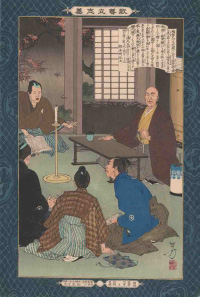
“Kyōdō Risshi Ki Hanawa Hokiichi”
Meiji 23rd (1890)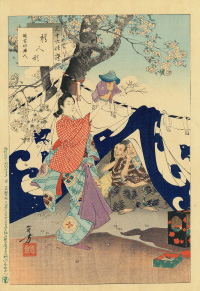
“Sanjū-rokka-sen Taru-ningyō Enpō koro no Hujin”
Meiji 25th (1892)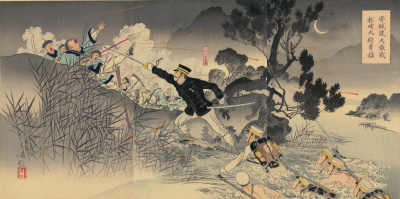
“Anjōwatashi Daigekisen Matuzaki Taii Yūmō”
Meiji 26th (1893)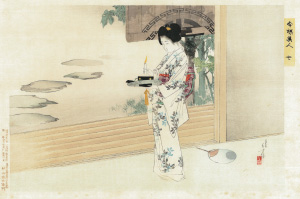
“Imayō Bijin Nana”
Meiji 32nd (1899)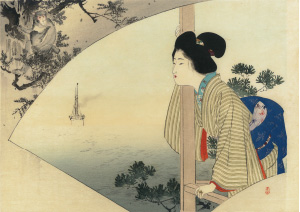
Kuchi-e Unkown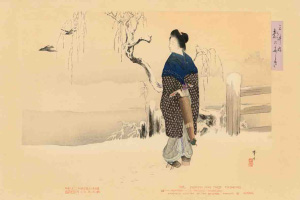
“Mituiyoshi Miyako no Nishiki Asa no Yuki”
Meiji 37th (1904)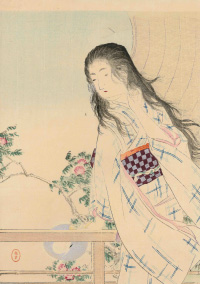
“Bungeikurabu Dai Jū-ni kan Jū-ni gō Iyosudare”
Meiji 39th (1906)
In the latter half of Meiji, many art works of hūzoku-ga in which the tradition of ukiyo-e was put were created mainly by the pupils of Toshikata and so on. We introduce the art works of Kaburaki Kiyokata and Ikeda Terukata who were the pupils of Toshikata.
●Kaburaki Kiyokata (1878 ~ 1972)
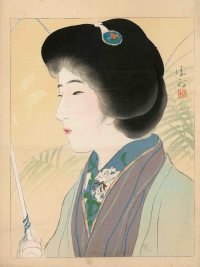
Kuchi-e “Yuriko Chū”
Taishō 2nd (1913)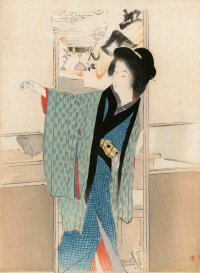
Kuchi-e Unkown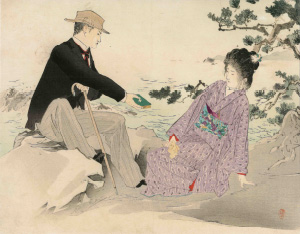
Kuchi-e “Chi-kyōdai Ato”
Meiji 37th (1904)
●Ikeda Terukata
Meiji 16th to Taishō 10th (1883 ~ 1921)

“Edo no Nishiki” Meiji 36th (1903)
- Ogata Gekkō Ansei 6th to Taishō 9th (1859 ~ 1920)Open or Close
In the first half of Meiji period, the pre-modern system of the sphere of activity and training for e-shi had collapsed on the one hand and the sphere of new activity and exchange such as the hand-painting on exports or illustration on newspapers was created on the other hand. Ogata Gekkō is a typical e-shi who became popular in that time by self-study and practice.
He was born in Kyobashi, Tokyo. Based on his father’s recommendation, he studied drawing by himself by sketching from when he was a child and spend a lot of time studying the style of Kikuchi Yōsai. When he was 17, his father passed away and he run a lantern shop. After that, he got to be popular in hand-painting on ceramic, illustration on newspaper or ukiyo-e. He deepened the exchange with Japanese drawing circles by sending his work to the first Kanga-kai (an exhibition) in Meiji 18th or so on. And he participated in the establishment of Nihon Seinen Kaiga Kyōkai in Meiji 24th. After that, he became a judge of Kyōshin-kai, became a regular member of Nihon Bijutu In (means, Japan Art Society) and contributed to producing modern Japanese drawing circles. His art work “Soga Yo-uchi” was brought by the Emperor Meiji in Meiji 31st. He sent his works to many exhibitions and got many prizes.
He created hand-drawings actively on the one hand and created illustrations, kuchi-e or ukiyo-e energetically on the other hand. In Meiji 20s and 30s when ukiyo-e was declining, he created several series of ukiyo-e such as “Gekkō Zuihitu”, “Hujin Hūzoku Zukushi”, “Genji Gojū-yo Jō”, “Gishi Shijū-shichi Shi Zu” and “Hyaku Huji”. His san-mai-mono (a work constructed by 3 prints) such as “Hana Bijin Meisho Awase” or “Bijin Meisho Awase” were highly regarded continuously. “Iroha-biki Gekkō Manga” which was published in 10 years from Meiji 27th, formed by 3 volumes, 21 books is also one of his masterpieces.
Ogata Gekkō did not have a specific teacher. Then at the dawn of modern publishing and modern Japanese drawing, he skilled up by self-studying and practicing, uniquely established hūzoku-ga of Edo and Meiji with refined and full of great feelings and got great popularity.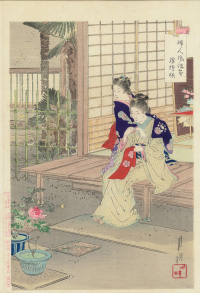
“Hujin Hūzoku Zukushi Nui Moyō”
Meiji 24th (1891)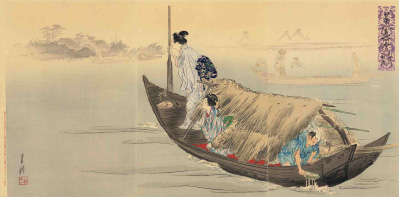
“Bijin Meisho Awase Tonegawa Koi-gyō”
Meiji 30th (1897)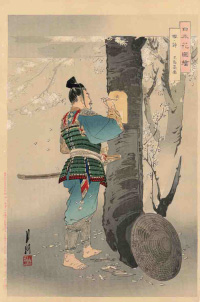
“Nihon Hana Zu-e Sakura no Uta Kojima Takanori”
Meiji 31st (1898)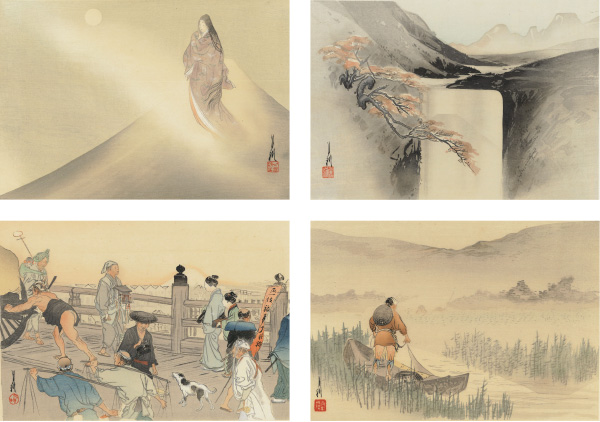
“Hyaku Huji”
Around Meiji 37th (1904)
“I-ro-ha-biki Gekkō Manga”
Meiji 27th ~36th (1894~1903)
